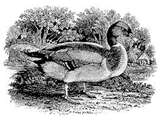Roast Duck with Bacon
There are a lot of good ways to roast a duck; unfortunately, as noted in the critical, the one outlined by Elizabeth David in A Book of Mediterranean Food is not among them. The addition of bacon to rich duck may seem like overkill, but the result has an unexpected and savory balance. Gravy is entirely optional, but delicious; recipes appear in the notes.
 -a 4-6 lb duck
-a 4-6 lb duck
-an onion, peeled and quartered
-salt and pepper
-6 slices of bacon (thicker is better)
Preheat the oven to 425°.
- Pat the duck dry, stab it at one inch intervals with a butcher’s fork and season its cavity with a generous jolt of salt and pepper, then pull the onion quarters apart and put them in the cavity.
- Season the duck all over with pepper, put the bacon slices across the breast and salt any of the skin that is not covered by the bacon.
- Put the duck on a rack (in a roasting pan of course) and place it in the oven for 5 minutes, then reduce the heat to 300°.
- Roast the duck for about 45 minutes to an hour, depending on its size and the nature of your oven.
- The bacon should be crisp but not charred; remove it from the oven, then increase the heat to 400° for another 15 minutes or until the skin is a deep and crispy brown.
- Remove the duck from the oven, tent it loosely with foil and let it stand for at least 15 minutes before carving. Serve with the bacon, or with some of the bacon and use the rest to make gravy.
Notes: You have flexibility in the length of time in which you choose to cook your duck. An internal temperature of about 180° probably is traditional; many people, chefs in particular, like to serve the breast like a rare steak; it is up to you. If, however, you want a rare breast, then you will need to use the legs for something other than dinner with the breast; they will not be cooked enough to taste good. We think that sometimes a traditionally roasted duck, analogous to medium beef (itself, however, entirely unacceptable) is nice.
- Like turkeys, different ducks of the same weight can require radically different cooking times. You need to be vigilant and flexible; the meat thermometer does help here.
- Use common sense about your bacon; get it out of the oven whenever it is done. Sometimes it will crisp more quickly than others. Alternatively you can dispense with the bacon altogether but we never want to do so.
- Do you know how to carve a duck? If not, get an extremely sharp knife and follow Donald Link’s simple instructions:
“ Place the duck on a cutting board. Disjoint and remove a leg and thigh from the side nearest you. Use a knife to remove the wings (they will come off easily). Slicing along the breastbone, gently remove the breast in one piece. Slice the breast on the slant to make nice medallions. Repeat with the other side.” Real Cajun (New York 2009) 139
- Link likes to make bacon gravy for his Thanksgiving turkey; we like a variation of it even better with duck. Pour all but about 4 Tablespoons of the drippings out of the roasting pan and whisk in the same amount of flour (we use Wondra) over medium heat until the fat and flour marry and turn beige. Sprinkle the roux with your choice of dried thyme, sage or oregano and slowly whisk about 2 to 3 cups of warm stock into the pan along with some Kitchen Bouquet, hot sauce and Worcestershire. Be sure to loosen the debris from the pan; do not waste that. Turn the heat to low and add two or three slices of the cooked bacon, which you have crumbled, to the gravy as it thickens. Check the seasonings, add about a Tablespoon of cold unsalted butter for gloss and then, if you like, 2 Tablespoons of lemon or sour orange juice. If you have giblets and like them too, boil them until tender while the duck roasts, chop them fine and add them to the gravy with the crumbled bacon.
- Dorothy Allison published a southern variation on bacon flavored gravy in The New York Times Magazine on 28 October 2007 under the apt title “Panacea.” She roasts her duck covered with bacon too but uses milk instead of stock; if you do too, then do not let the flour color as much, omit the Kitchen Bouquet, Worcestershire, crumbled bacon and citrus, and substitute a little cayenne for the hot sauce. Chop and fry giblets if you have them, and add them to the panacea.
- As Elizabeth David knew, eighteenth century cooks served up duck with a boat of hot unadulterated port, a nice counterpart to the rich meat and a lot less trouble than a fruit sauce, which anyway usually seems cloying. Recommended.
- Yellow turnips are a traditional side dish for duck; whether you serve them boiled, mashed and seasoned simply with butter, salt and pepper, or roasted in the fat of the duck pan, they are hard to beat with this bird. A watercress salad, or even a naked (but generous) garnish is a welcome counterpoint to your duck and turnips.

